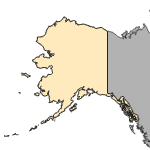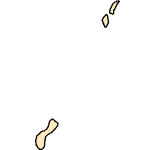Monopterus sp.
(jowled swamp eels)
Fishes
Exotic |
|
Common name: jowled swamp eels
Taxonomy: available through
www.itis.gov
Identification: This species is not M. albus. Species is yet unidentified. Asian swamp eels are morphologically similar to two North American native fishes: American eel (Anguilla rostrata) and lampreys (Ichthyomyzon, Lampetra, Lethenteron, or Petromyzon spp.). Asian swamp eels can be distinguished from American eels by the presence/absence of pectoral fins (present in A. rostrata; absent in Monopterus sp.). Swamp eels can be distinguished from lampreys by the morphology of the gill opening (a single V-shaped opening in swamp eels; 7 small, pore-like gill openings in lampreys) and mouth/teeth (lampreys lack jaws and have an ovoid oral disc with embedded teeth). Swamp eels are also morphologically similar to two native salamanders (Siren and Amphiuma spp.), but can be distinguished by the presence/absence of legs/limbs (front and hind legs present in Amphiuma, front legs only in Siren, no legs/limbs in Monopterus). An identification guide highlighting to distinguishing swamp eels from the taxa outlined above can be downloaded here.
Native Range: Asia.



|

Alaska |

Hawaii |

Puerto Rico &
Virgin Islands |

Guam Saipan |
Hydrologic Unit Codes (HUCs) Explained
Interactive maps: Point Distribution Maps
Nonindigenous Occurrences:
Numerous individuals were released in the Passaic River in New Jersey in August 2007 as part of a Buddhist prayer release, along with many frogs and turtles (Henry 2007a, b, c).
Table 1. States with nonindigenous occurrences, the earliest and latest observations in each state, and the tally and names of HUCs with observations†. Names and dates are hyperlinked to their relevant specimen records. The list of references for all nonindigenous occurrences of Monopterus sp. are found here.
Table last updated 1/21/2026
† Populations may not be currently present.
Means of Introduction: Buddhist prayer release.
Status: Unknown.
Impact of Introduction: The impacts of this species are currently unknown, as no studies have been done to determine how it has affected ecosystems in the invaded range. The absence of data does not equate to lack of effects. It does, however, mean that research is required to evaluate effects before conclusions can be made.
References: (click for full references)
Henry, S. 2007a. Buddhists release creatures into Passaic. Herald News. West Paterson, NJ. http://northjersey.com/page.php?qstr=eXJpcnk3ZjczN2Y3dnFlZUVFeXkzNTcmZmdiZWw3Zjd2cWVlRUV5eTcxODE0OTQmeXJpcnk3ZjcxN2Y3dnFlZUVFeXky. Created on 08/13/2007. Accessed on 10/22/2007.
Henry, S. 2007b. Authorities find a lot wrong with Buddhist reptile rite. Herald News. West Paterson, NJ. http://www.northjersey.com/page.php?qstr=eXJpcnk3ZjcxN2Y3dnFlZUVFeXk3JmZnYmVsN2Y3dnFlZUVFeXk3MTgxNzk1. Created on 08/14/2007. Accessed on 10/22/2007.
Henry, S. 2007c. Origin of reptiles remains a mystery. Herald News. West Paterson, NJ. http://www.northjersey.com/page.php?qstr=eXJpcnk3ZjcxN2Y3dnFlZUVFeXkzJmZnYmVsN2Y3dnFlZUVFeXk3MTg0MzI4. Created on 08/20/2007. Accessed on 10/22/2007.
Nico, L.G., P. Sharp, and T.M. Collins. 2011. Imported Asian swamp eels (Synbranchidae: Monopterus) in North American live food markets: potential vectors of non-native parasites. Aquatic Invasions 6:69-76.
Author:
Matt Neilson, and Pam Fuller
Revision Date: 5/9/2019
Peer Review Date: 9/3/2013
Citation Information:
Matt Neilson, and Pam Fuller, 2026, Monopterus sp. Lacepède, 1800: U.S. Geological Survey, Nonindigenous Aquatic Species Database, Gainesville, FL, https://nas.er.usgs.gov/queries/FactSheet.aspx?speciesID=2740, Revision Date: 5/9/2019, Peer Review Date: 9/3/2013, Access Date: 1/21/2026
This information is preliminary or provisional and is subject to revision. It is being provided to meet the need for timely best science. The information has not received final approval by the U.S. Geological Survey (USGS) and is provided on the condition that neither the USGS nor the U.S. Government shall be held liable for any damages resulting from the authorized or unauthorized use of the information.